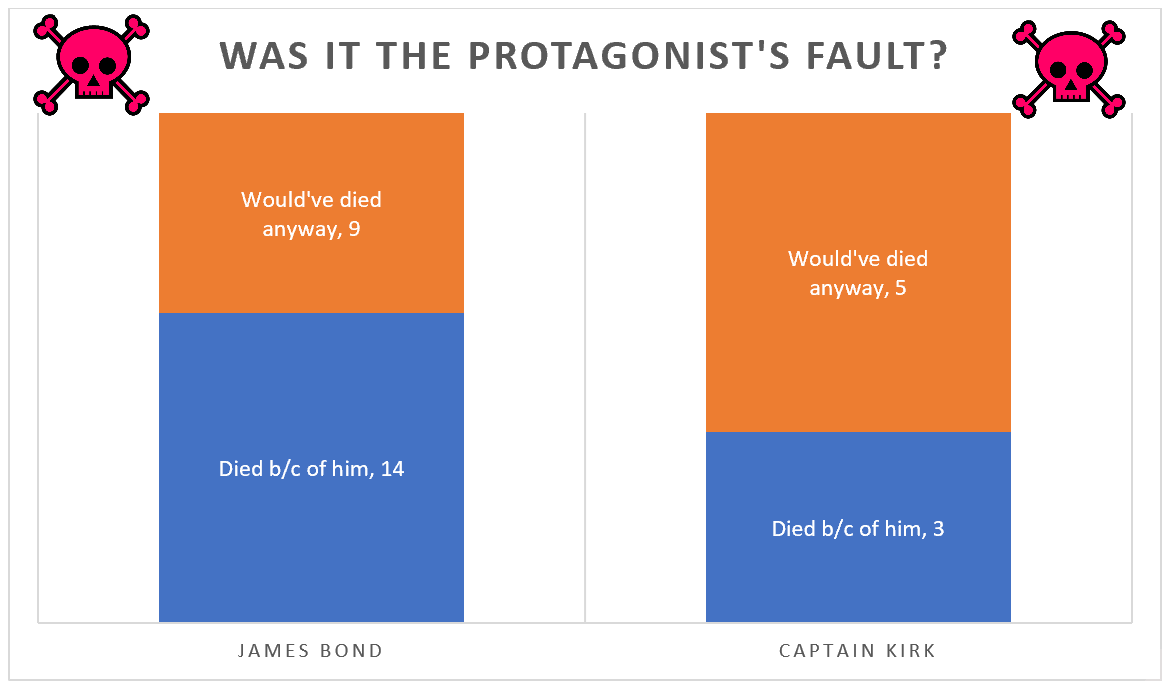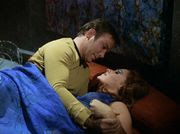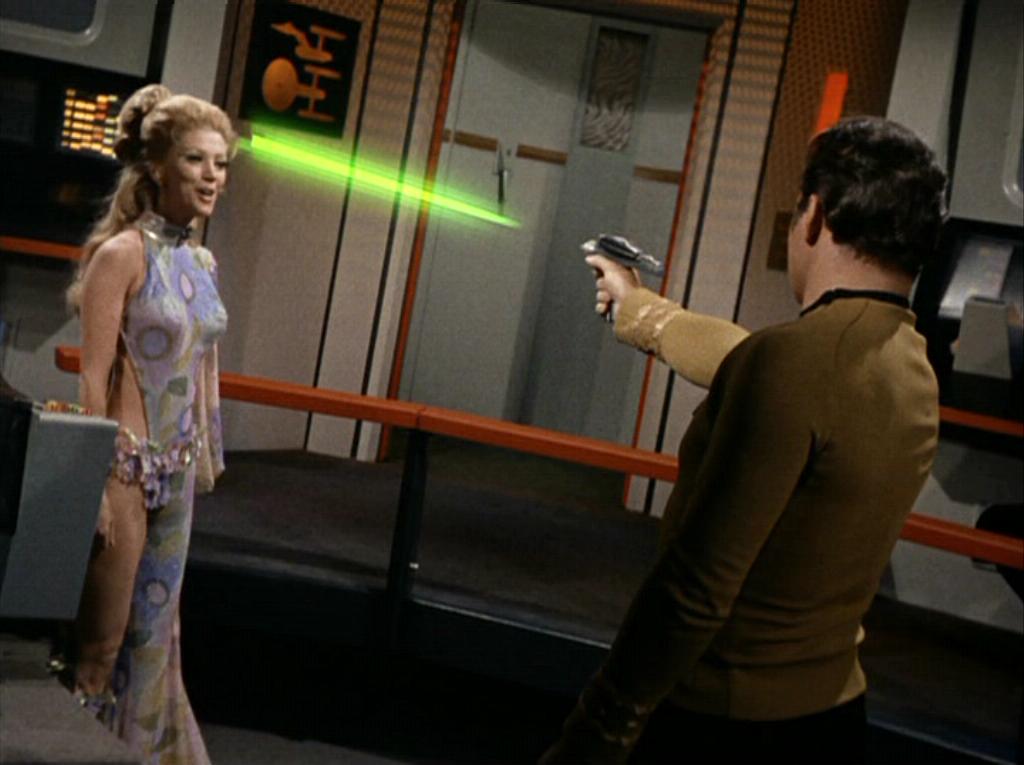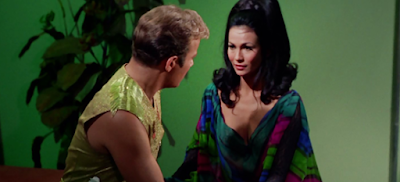
Captain's Log: All My Girlfriends Are Dead
March 16, 2020
Welcome back to your favorite feminist-critique blog about macho franchises. Last post, we discussed the presence of women in the world of original-series Star Trek, both on- and off-screen. Now, we shall turn our attention to the specific subset of those women who romance Captain Kirk, and/or die trying.
The Character

The protagonist of Star Trek, James Tiberius Kirk, is the captain of the starship Enterprise. Aided by his best friends, science officer Spock and ship's surgeon Dr. McCoy, he flies around the universe having adventures.
According to the fan site Memory Alpha, Kirk was born in Riverside, Iowa, Earth in 2233, and died in 2371 on Veridian III. The existence of time travel, suspended animation, counter-clock universes, and something called "the Nexus" makes it hard to tell how old he was at the time of his death.
William Shatner originated the role and appeared in:
- 73 episodes of the original series Star Trek (1966-1969), hereinafter "TOS;"
- 22 episodes of an animated series, also called Star Trek (1973-1974), hereinafter "TAS;"
- 7 feature films (1979-1994).
His franchise total adds up to roughly 83 hours of screen time. That is 60% more than our previous study subject, James Bond, who has 50 hours and counting. Still, you know what they say: it's not the hours, it's the mileage.
Qualifications as a Contestant
TOS was non-serialized; every episode had to have a self-contained story. Thus no main character could have a long-term love interest, unless s/he got involved with another series regular (which never happened.)* In addition, Kirk has a reputation as a ladies' man both in-universe and out. The corollary is that Kirk has had a lot of short-term relationships.
*Note: There's considerable fan speculation that Kirk and his first officer, Mr. Spock, are romantically involved off-screen. Back in the 70s, such speculation led to the coining of the term "slash fiction," which refers to fan fiction in which characters who present as heterosexual in-universe are written as homosexual. I will not comment on the Kirk/Spock subtext here, since it is non-canonical. It is noteworthy, however, that Spock was the first Trek character to rise from the dead. If he and Kirk actually were together, then Kirk would have Schrodinger's dead boyfriend in addition to his dead girlfriends.
At any rate, Kirk is not the settling-down type. In fact, referring to the women in his life as "girlfriends" is almost too generous; most of them don't make it to a second date. The existence of multiple ex-girlfriends he runs into (or mentions) would seem to suggest that he has had serious, committed relationships at some point in his life, however. See, for instance, Carol Marcus (Wrath of Khan), Ruth ("Shore Leave"), Areel Shaw ("Court Martial"), Janet Wallace ("The Deadly Years") and Janice Lester ("Turnabout Intruder"), as shown in this slideshow:
Evidently, however, Kirk is over the monogamy idea by the time he gets promoted to captain. The longest relationship he has on-screen only lasts for approximately 10-12 weeks, and it only goes that far because he has amnesia at the time.
Proposed in-universe explanations for why Kirk can't maintain a relationship include:
- Commitment isn't a widely-expected lifestyle in the free-love future.
- His one true love is his ship, the Enterprise.
- He's had his heart broken by too many girlfriends dying.
Versions
A character named James T. Kirk also appears in the 2009 movie Star Trek, as well as its two sequels, Star Trek Into Darkness and Star Trek Beyond. In these incarnations, the character is played by Chris Pine. I have excluded Pine!Kirk from this study, however, because those movies take place in an alternate universe to TOS. From the following differences, it is clear that Pine!Kirk is not intended to be the same character as Shatner!Kirk:
| Pine!Kirk | Shatner!Kirk | |
| Eye Color | blue | hazel |
| Birthplace | escape shuttle fleeing the USS Kelvin during attack by time-traveling Romulans | Riverside, Iowa |
| Path to Command | Conning his way into a first-officer role and outliving the previous captain | Graduation from Starfleet Academy + 15 years of rank-climbing |
| Number of Times He's Destroyed the Enterprise | 3 | 1 |
| Why Khan hates him | No particular reason | He marooned the bastard on a barren world for 18 years |
| How he knows Carol Marcus | Professionally | Biblically |
While Pine!Kirk has at least one dead girlfriend, therefore, all of the below stats will apply only to Shatner!Kirk.
The Study
In a way, I began this study in 2001, when my family got its first basic-cable package and I could watch Trek reruns on the SciFi channel. Without a DVR, however, I inevitably missed a few episodes. For over a decade, I only knew "The Cloud Minders" from the description that my sister gave me over the phone, while she watched it and I listened from our grandmother's house.
Luckily for me, Netflix has since put the whole Star Trek kit and kaboodle online. All I had to do was sit down and watch it, while keeping track of the fates of women in a Google Sheet.
As an interesting side bonus, listening to the opening monologue over and over inspired me to study it from a linguistic standpoint, and turn it into a presentation that I give at TESOL conventions. Yes, really.
Results
Captain Kirk had 31 romances: 28 from TOS and 3 from the feature films. This works out to 1 woman per 2.6 hours of screen-time. This means that his girlfriends are both less numerous and less frequent than those of James Bond, who averages 1 woman per 1.5 hours of screen time.
The Kirk girls have one feature that the Bond girls cannot hope to beat, however: only 17 out of the 31 of them are confirmed to be humans. The rest are either humanoid aliens or gyndroids. This gives our hero about a 1 in 2 chance of falling for a nonhuman in any given situation.
The logistics of that are mostly left unexplained, which is probably a good thing.
Before you ask, yes, that was "gyndroids" in the plural. Kirk does, in fact, get involved with two completely-unrelated sentient female robots, the latter of which is literally using him as a romantic Turing test. Both gyndroids die.
Mortality Rate
Of the 31, the audience sees 8 die, which is a 25.8% mortality rate. While this is a pretty grim statistic, it is both a lower percentage and a lower total than the Bond girls.

Causes of Death
The 8 deaths are as follows:
- Andrea, the first gyndroid, commits murder-suicide with her creator;
- Edith Keeler, gets hit by a truck because of historical determinism;
- Sylvia, dies after Kirk breaks her magic wand;
- Miramanee, is stoned to death by an angry crowd that has just realized Kirk is not a god;
- Nonna, becomes the first casualty of a war she's been trying to start;
- Marta, is executed by a lunatic who's running his own asylum;
- Rayna, the second gyndroid, overloads her circuits while having an emotional epiphany;
- Martia, gets vaporized by Klingon guards while trying to escape a penal colony.
I've assembled all 8 death scenes into the following supercut, for your viewing pleasure.
As a follow-up question, I asked myself, "How many of these deaths were a result of encountering Captain Kirk?" In other words, would she still be dead if she'd never met him? This was a complicated question to answer because it's not always clear, in the Star Trek universe, which causes produce which effects. Edith Keeler, for example, exists in at least 3 timelines: one in which she died in a traffic accident; one in which she avoided the accident but consequently the Nazis won World War II; and one in which Kirk let her die to prevent timeline #2 from coming true. Did he actually kill her, or merely allow history to take its proper course? Meet me in the comments for an engaging debate!
Culpability is usually more clear-cut in the Bond universe, where 007 routinely uses women as human shields.
At minimum, however, I think we can blame Kirk for 3 deaths: Sylvia's because he kills her, Miramanee's because she dies protecting him, and Marta's because the madman executes her to intimidate Kirk. This gives him a culpability rate of 37.5%, which is lower than Bond's 61.9%, or 14 out or 23, culpability.

Before Kirk gets too smug, however, I should note that death is not the only threat to Kirk's women. Of the ones who survived, there were at least two mental breakdowns: Lenore Karidian lost her mind while trying to kill off everyone who knew that her father was an escaped mass murderer, and Dr. Janice Lester went crazy because of the sexism in Starfleet. Furthermore, both Drusilla ("Bread and Circuses") and Shahna ("Gamesters of Triskelion") were slaves at the time of their romance with Kirk, and he left both of them enslaved. Taken together, these cases suggest that Kirk is just too self-centered to worry about what will happen to any of his exes, which might be another reason why he never settles down.
Pregnant Mortality Rate
Unlike James Bond, Captain Kirk is known to be fertile. In fact, whatever futuristic contraception he's using must have a high failure rate, because he apparently impregnates all 3 of his confirmed sex partners.
"Wait, only 3?" I hear you cry. Well, yes, this was network TV in the 1960s. In most situations, sex could only be implied, not confirmed.
The three ladies-of-debatable-luck were as follows:
Miramanee, "The Paradise Syndrome"
In an episode aired October 4, 1968, the Enterprise crew visits planet Amarind. There, they discover human Native Americans, who have been living there for centuries. A master race had transported some tribes from Earth to Amarind to save them from genocide, and thus the noble savages have never had a reason to progress beyond pre-Columbian technology. While exploring a monument from the master race, Kirk is separated from his crew, develops amnesia, and gets mistaken for a god.
Everybody got that? Great! Time for the first commercial break.
The mistaken-for-divine-white-guy quickly transforms Amarind society by inventing amazing technology, like lamps and CPR. He also gets married to a local girl, Miramanee, and they conceive a child. But weeks later, the tribe realizes Kirk isn't a god, and starts throwing Styrofoam rocks at him. Miramanee dies in the crossfire, the Enterprise crew returns in time to rescue Kirk, and he's free to leave his dead pregnant wife and return to starship captain-ing.
If you're rolling your eyes at this, you're not the only one. This episode embodies every cringe-worthy stereotype about 1960s media. Essentialized Native Americans? Check. An exotic love interest who provides a nice break for the overworked, troubled white man? Check. A woman who conveniently dies so that the main character won't have to think about her ever again? Check.
To make matters worse, I recently discovered that in the first draft of the script, Miramanee was supposed to live. Kirk was merely going to abandon her and go back to the Enterprise. Her fate was changed because of the intervention of an NBC censor, Stanley Robinson, who thought abandoning a pregnant wife would be too immoral for the audience:
We must remember that even though our series takes place at a time in the future, we still have contemporary people with contemporary views on morals, manners, etc., viewing our shows and, while we are able to portray others than our heroes in opposition to these conventional points of view, we should not ever depict our leads as having such thoughts. - Letter to Gene Roddenberry, April 1, 1968, quoted in Star Trek and History (1998)
In other words, the screenwriters killed off a woman of color in order to preserve the virtuous reputation of a white man.
Like all the dead women on Star Trek, Miramanee is never mentioned again.
Deela, "Wink of an Eye"
6 weeks after "The Paradise Syndrome," NBC aired "Wink of an Eye," in which Captain Kirk gets kidnapped and used for breeding purposes. Among all our contestants, this is a situation unique to Captain Kirk.
The Enterprise visits planet Scalos, where radiation poisoning has rendered all the men sterile while simultaneously speeding up the women's molecules until they're moving too fast for humans to see. Queen Deela uses her invisibility to spike Kirk's drink with a drug that speeds him up, too, and then demands that he have sex with her to help repopulate her planet.
I should note that in 1968, the word "rape" would not have been applied to this situation. That's because, until 2013, the FBI defined rape as "the carnal knowledge of a female, forcibly and against her will." Kirk, being male, quite literally couldn't be raped under that definition. Under modern definitions, however, Deela is definitely committing a sex crime.
Regardless of terminology, this dubiously-consensual situation should be complicated by the fact that they're members of different species, and thus shouldn't be able to mutually reproduce. But if you think anyone in-universe mentions that, then you don't know Star Trek. Instead, Spock and McCoy focus on finding a cure for the speeding disease, while Kirk obligingly has sex with Deela to keep her distracted.
Once Kirk is cured, he sends Deela back to her planet, without offering her people the cure. There very well could be a technobabble explanation for this (e.g. Scalosians oppose modern medicine, cure only works on humans, Federation regulations call for the withholding of medication from rapey civilizations, etc.) - but, the writers didn't write one, so the audience has to make up their own.
Ah well, at least they didn't kill her off.
Carol Murphy, Wrath of Khan (1982)
Finally, in the second Star Trek feature film, Admiral Kirk mounts a rescue operation for one Dr. Carol Marcus. When he finds her, however, he's immediately attacked by her son, Dr. David Marcus. In a shocking twist, it turns out that Jim is David's father, but they've never had a relationship.
The explanation for this estrangement is left pretty vague; Carol apparently asked Kirk to "keep his distance" for reasons unknown. It is also unclear how long David has known who his father is. He initially refers to Kirk as "that overgrown boy scout [Carol] used to hang around with," but later reveals that he is "proud to be [Kirk's] son."
Since Stanley Robinson wasn't around to demand more 20th-century morality, nobody in-universe comments negatively on this situation. This suggests that the range of socially-acceptable family models has broadened in the future, and the audience must simply keep up as best they can.
The David Marcus character recurs in The Search for Spock (1984), and his subsequent death provides some of Kirk's character motivation in movie 6, The Undiscovered Country (1991). Carol Marcus, on the other hand, survives the events of Wrath of Khan and is never mentioned again. Which means we have a final number here...
Mortality Rate of Pregnant Girlfriends: 33.3%
Nefarious Intentions Rate
This category is where the Kirk girls really start to shine. A full 45.16% of them are trying to manipulate or harm him in some way. This is more than double the rate among Bond girls. In addition to the aforementioned kidnapping-for-breeding-purposes, Kirk has had women attempt to:
- Murder him because he witnessed the genocide her father committed;
- Put a spell on him while curing him of a poisonous monkey bite;
- Slip him a love potion because he calls her a spoiled brat;
- Catch a deadly disease from him in order to DIY a plague on her overpopulated home planet;
- Forcibly swap bodies with him to usurp his command;
...and I'll stop there. Please note that I am not making any of these up; actual professionals got paid to write these plots.
Kirk also had less-than-honorable intentions towards 16.12% of the women. His motivations, however, were more often on the order of "I need some information/a diversion/a way to confuse this alien in order to save my ship! Also, I am pretty unimaginative. I'd better trade on my good looks."
Observations
Although he gets around a bit, Captain Kirk is not as sleazy or cavalier about the women in his life as Bond is. This is especially notable because, with 430 people on his crew, he's probably the boss of 200+ women. Yet he makes a point of not putting them in inappropriate situations - which is why the behavior of his evil side in "The Enemy Within" is so shocking. In "Dagger of the Mind," he's noticeably embarrassed by the fact that he once flirted with a subordinate at a Christmas party, even though said flirtation only extended to "talking, dancing, and watching the stars."
In fact, in "Mirror, Mirror," Kirk is shocked to learn that his alternate-universe counterpart has a significant other from within the crew. His reaction to Marlena's existence involves reassuring her that she doesn't have to be a "captain's woman," because "You can be anything you want to be."
| Pictured: Kirk advising a woman to "lean in." |
There is also a serious contrast between how James Bond reacts to losing a woman, and how Kirk reacts. You see, James Bond has cried on screen exactly twice: in 1969 and 1989. Otherwise, he barely emoted until the 1990s. As a result, he's far too calm around death. One scene in 1967's You Only Live Twice has a woman die of poisoning while in bed with 007, after which he coolly starts discussing the next step in his plan, while he's still in the room with her corpse.
Kirk, meanwhile, gets so upset over death that Mr. Spock once mind-wiped him to get him to calm down.
Also, in 1967, nothing made Kirk panic more than the thought that his friend Lt. Uhura might be in danger.
All in all, Kirk is winning when it comes to emotional vulnerability, even if he can't beat James Bond's total number of dead girlfriends.
Conclusions
Captain Kirk is in second place for Number of Dead Girlfriends, Percentage of Girlfriends who Die, and Percentage of Personal Responsibility for Deaths.
He is in first place for Pregnant Mortality Rate, Nefarious Intentions Rate, and the uncontested Number of Nonhuman Girlfriends.
I hereby award an Honorable Mention to Captain Kirk for Number of Girlfriends who had Mental Breakdowns.
Most importantly, the Star Trek franchise wins Best Intentions Gone Awry, hands-down. Unlike some of their competitors, Gene Roddenberry and Desilu didn't necessarily set out to make "a man's show." Yet somehow that's what they made. It's undeniable that Trek was trying very hard to be progressive, even if some of their pet causes - racial integration! responsible decolonization! reconciling with the USSR! - are now taken for granted. When it came to women's liberation, however, Trek stumbled.
That is not to say that the creators made no effort to include women in their vision of the future. As my last entry established, D.C. Fontana was with Gene Roddenberry on every step of the trek, just as Lt. Uhura was absolutely with the Enterprise from first to last. Trek also quickly gained legions of female fans, whose multi-generational devotion has lasted for over 5 decades. We, the women who love Trek, have helped to keep its flame alive across cancellations, syndication, resurrection, and mutation. There have always been women in, on, and around Star Trek.
If you scratch the surface of TOS's writing, though, its patriarchy starts to show. Look at the following examples:
- In the second pilot, a man refers to a woman as a "walking freezer unit." She apologizes to him for not smiling more at work and admits, "Women professionals do tend to overcompensate."
- In "Space Seed," a professional anthropologist betrays the Enterprise crew because she dislikes modern, civilized men and has fallen for a verbally abusive, dominant man who has just woken up from a centuries-long cryosleep.
- The opening scene of "Who Mourns for Adonais?" has Dr. McCoy matter-of-factly remarking that all female crewmembers who get married leave Starfleet. This prompts Kirk to complain, "I like to think of it not so much losing an officer as gaining...Actually, I'm losing an officer."
- In the final episode, we find out that the aforementioned Janice Lester has been refused opportunities to captain a starship because of her gender. Her reaction is to kidnap Captain Kirk, force him to swap bodies with her, usurp his ship, and then repeatedly try to have him killed. At one point, she exclaims, "Believe me, it's better to be dead than to live alone in the body of a woman."
I assume you're seeing the pattern here. The screenwriters could imagine a future in which a peaceful interspecies government explored the universe at 10 times the speed of light. They couldn't picture a world in which women worked after marriage, demanded good behavior from men, or never had their professionalism questioned. Also, they apparently thought feminists would go mad if they didn't learn to behave in a man's world.
In other words, whenever the screenwriters decided to bump off a girlfriend for cheap drama, they weren't doing so in a vacuum. The dead ladies on Star Trek were a natural result of the sexist environment in which the show was created.
Remember, representation matters because the stories we tell tend to shape what we imagine is possible. Because the screenwriters couldn't imagine gender equality, Trek couldn't demonstrate it, which meant that American kids in the audience couldn't picture it, either. Although Star Trek helped humans to imagine many great things (e.g. cell phones, nuclear disarmament, comic-con), feminism wasn't among them, at least not at first.
Fortunately, the franchise has lived long and prospered, and it has moved towards a less sexist stance over the past 5 decades. To a modern audience, Captain Kirk's dead girlfriends should be a reminder of how far we've come, and why it's important to hold your entertainment to a higher standard. Ultimately, only the audience can save the dead girlfriends.



